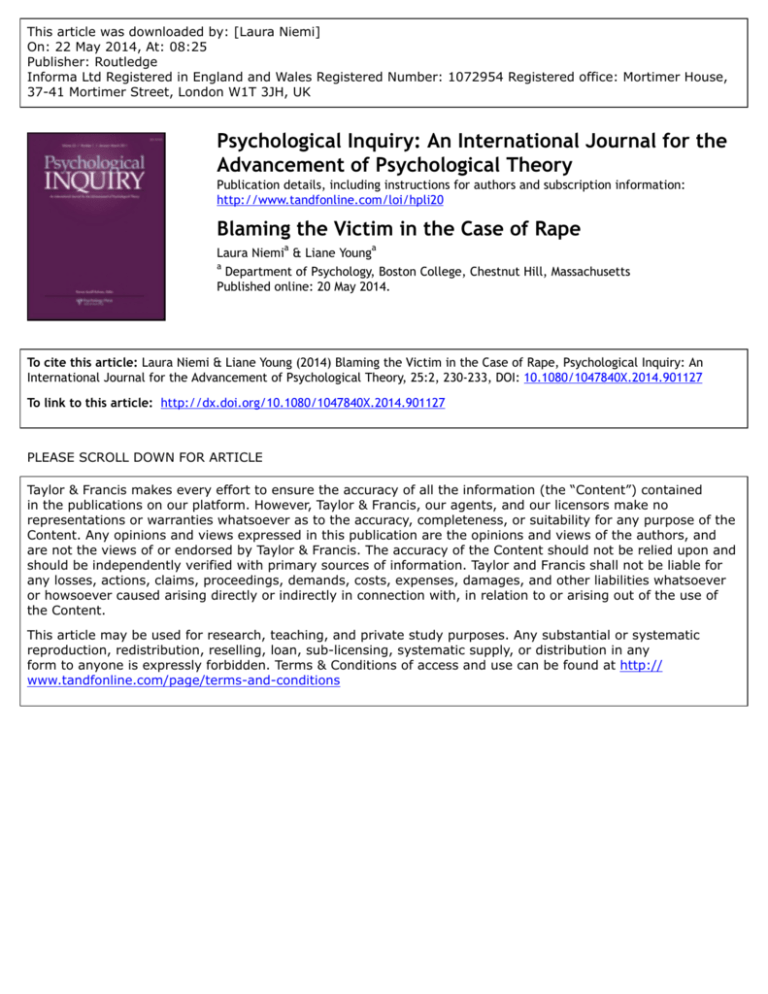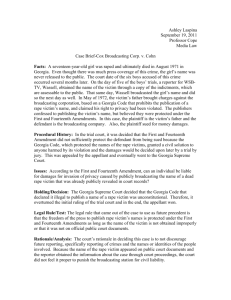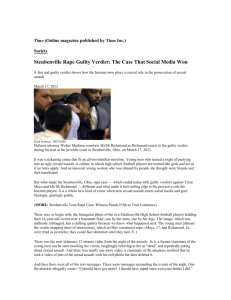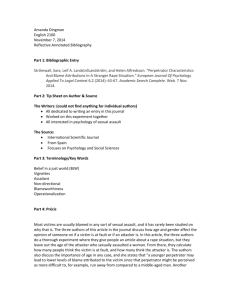
This article was downloaded by: [Laura Niemi]
On: 22 May 2014, At: 08:25
Publisher: Routledge
Informa Ltd Registered in England and Wales Registered Number: 1072954 Registered office: Mortimer House,
37-41 Mortimer Street, London W1T 3JH, UK
Psychological Inquiry: An International Journal for the
Advancement of Psychological Theory
Publication details, including instructions for authors and subscription information:
http://www.tandfonline.com/loi/hpli20
Blaming the Victim in the Case of Rape
a
Laura Niemi & Liane Young
a
a
Department of Psychology, Boston College, Chestnut Hill, Massachusetts
Published online: 20 May 2014.
To cite this article: Laura Niemi & Liane Young (2014) Blaming the Victim in the Case of Rape, Psychological Inquiry: An
International Journal for the Advancement of Psychological Theory, 25:2, 230-233, DOI: 10.1080/1047840X.2014.901127
To link to this article: http://dx.doi.org/10.1080/1047840X.2014.901127
PLEASE SCROLL DOWN FOR ARTICLE
Taylor & Francis makes every effort to ensure the accuracy of all the information (the “Content”) contained
in the publications on our platform. However, Taylor & Francis, our agents, and our licensors make no
representations or warranties whatsoever as to the accuracy, completeness, or suitability for any purpose of the
Content. Any opinions and views expressed in this publication are the opinions and views of the authors, and
are not the views of or endorsed by Taylor & Francis. The accuracy of the Content should not be relied upon and
should be independently verified with primary sources of information. Taylor and Francis shall not be liable for
any losses, actions, claims, proceedings, demands, costs, expenses, damages, and other liabilities whatsoever
or howsoever caused arising directly or indirectly in connection with, in relation to or arising out of the use of
the Content.
This article may be used for research, teaching, and private study purposes. Any substantial or systematic
reproduction, redistribution, reselling, loan, sub-licensing, systematic supply, or distribution in any
form to anyone is expressly forbidden. Terms & Conditions of access and use can be found at http://
www.tandfonline.com/page/terms-and-conditions
Psychological Inquiry, 25: 230–233, 2014
Copyright Ó Taylor & Francis Group, LLC
ISSN: 1047-840X print / 1532-7965 online
DOI: 10.1080/1047840X.2014.901127
Blaming the Victim in the Case of Rape
Laura Niemi and Liane Young
Downloaded by [Laura Niemi] at 08:25 22 May 2014
Department of Psychology, Boston College, Chestnut Hill, Massachusetts
Ahrens, Sefl, & Barnes, 2001; Daly & Bouhours,
́
2010; Krahe et al., 2007; McGuire, Donner, & Callahan, 2012). In this commentary, we investigate
whether the Path Model of Blame accommodates the
phenomenon of victim blaming, as often observed in
the case of rape.
The most straightforward application of the
model to the case of rape proceeds as follows
(Figure 1, left panel). First, observers detect rape as
the norm-violating event. Second, observers detect
the rapist as the causal agent. Third, observers determine the rapist’s intentions and reasons. Finally,
observers assign some degree of blame to the rapist.
As such, the path model accounts for how observers
might assign blame to the perpetrator, that is, the
rapist, in the case of rape. How might the path
model apply to the victim? Following event detection is determination of agent causality: Did the victim cause the rape? A negative answer here results
in no blame assigned to the rape victim (Figure 1,
right panel).
Yet, as evidence indicates, observers often assign
́
blame to rape victims (e.g., Bieneck & Krahe, 2011;
́
Catellani et al., 2004; Jones & Aronson, 1973; Krahe
et al., 2007; McCaul et al., 1990). For illustration, we
start with a case study: Recently publicized incidents
at Patrick Henry College (PHC), which highlight the
complex psychology of blame in the case of sexual
assault. When a PHC student brought her own experience of sexual assault to the attention of the Dean of
Student Affairs, she received the following response
(Feldman, 2014): “You are in part responsible for
what happened, because you put yourself in a
compromising situation. . . . Actions have consequences” (para. 72). The suggestion here is that
responsibility and, likely, blame are appropriately
assigned at least in part to the alleged victim. But if
the perpetrator (and not the victim) in the case of sexual assault is the causal agent (Figure 1, left panel),
how are we to make sense of victim blaming? Can
both the victim and the perpetrator be causal agents?
According to the dean’s statement just presented, a
victim, by her “action” of being present, can be “in
part responsible” for the perpetrator’s decision to
rape her.
We turn to the question of whether the Path Model
of Blame accommodates victim blaming. We think
that Malle et al. specify a series of conditions that
At the heart of “A Theory of Blame” is the Path
Model of Blame, a map of the four or five information-processing steps that Malle, Guglielmo, and
Monroe (this issue) propose are necessary and sufficient to account for observers’ ascription of blame to
norm violators. The path model outlines the routes to
blame from event detection onward and includes
judgments of agent causality and intentionality as
well as finer distinctions involving consideration of
the agent’s reasons, obligations, and capacity to act in
relation to the event.
Our recent research has focused on cases that
may represent exceptions to standard models of
blame, including perhaps the Path Model of
Blame—sexual assault1 and rape.2 On one hand,
rape involves a clear perpetrator (the rapist) and a
clear victim (the individual who is raped); observers may be expected to assign blame to the perpetrator and to the perpetrator alone. On the other
hand, assigning some degree of blame to rape vić
tims is not uncommon (e.g., Bieneck & Krahe,
2011; Catellani, Alberici, & Milesi, 2004; Jones
́
́
& Aronson, 1973; Krahe, 1991; Krahe, Temkin, &
Bieneck, 2007; McCaul, Veltum, Boyechko, &
Crawford, 1990). Indeed, the basic pattern of relatively lenient judgments of perpetrators alongside relatively harsh judgments of victims in the case of rape
has been found in examinations of legal and medical
proceedings, as well as social psychological experiments in which participants assign blame in the case
of rape versus nonsexual crimes such as robbery
́
(e.g., Bieneck & Krahe, 2011; Campbell, Wasco,
1
Sexual assault has been defined by the National Institute of
Justice: “Sexual assault covers a wide range of unwanted behaviors—up to but not including penetration—that are attempted or
completed against a victim’s will or when a victim cannot consent
because of age, disability, or the influence of alcohol or drugs. Sexual assault may involve actual or threatened physical force, use of
weapons, coercion, intimidation, or pressure” (National Institute of
Justice, 2010).
2
Rape has been defined by the National Institute of Justice:
“Most [rape] statutes currently define rape as nonconsensual oral,
anal, or vaginal penetration of the victim by body parts or objects
using force, threats of bodily harm, or by taking advantage of a victim who is incapacitated or otherwise incapable of giving consent.
Incapacitation may include mental or cognitive disability, selfinduced or forced intoxication, status as minor, or any other condition defined by law that voids an individual’s ability to give consent” (National Institute of Justice, 2010).
230
COMMENTARIES
PERPETRATOR FOCUS MODEL 1
VICTIM FOCUS MODEL 1
Event Detection
Rape
Event Detection
Rape
No
Agent Causality
No
Blame
Did the victim cause
the rape?
Yes
Yes
Yes
No
Agent Causality
No
Blame
Did the perpetrator
cause the rape?
No
Intentionality
Yes
Did the perpetrator intend
to cause the rape?
No
Intentionality
No
No
Obligation
Obligation
Reasons
Low/No
Blame
Yes
Yes
Reasons
Capacity
Yes
Capacity
No
Yes
No
Degrees
of Blame
Degrees
of Blame
Downloaded by [Laura Niemi] at 08:25 22 May 2014
Low/No
Blame
Figure 1. Malle et al.’s Path Model of Blame applied to evaluation of the perpetrator (left panel) and the victim (right panel) in the case of
rape. (Color figure available online.)
may pave the way for victim blaming (Figure 2).
First, victim blaming requires ascribing causality to
the victim for the perpetrator’s action; such ascriptions of causality are consistent with the dean’s statement. The next question is whether the victim
intended to cause herself to be raped. Assuming the
VICTIM FOCUS MODEL 2:
A PATH TO VICTIM-BLAMING
Event Detection
Rape
No
Agent Causality
No
Blame
Did the victim cause
the rape?
Yes
Yes
No
Intentionality
Did the victim intend
to cause the rape?
No
Obligation
Reasons
Low/No
Blame
Yes
Capacity
Degrees
of Blame
Yes
No
Figure 2. Malle et al.’s Path Model of Blame applied to evaluation
of the victim in the case of rape. Note. Here, when the victim is
determined to have caused the event at least in part, degrees of
blame may be assigned to the victim. (Color figure available
online.)
answer is “No,” the next step is to determine whether
the victim had an obligation to prevent causing
the rapist to rape her. If the answer here is “Yes,” the
next step is to determine whether the victim had the
capacity to fulfill her obligation. If the answer here is
“Yes,” then the victim will be ascribed some degree
of blame (Figure 2). If not, “low blame” and “no
blame” judgments remain options.
Let’s take a closer look at the critical notion of
obligation. The dean’s statement represents a certain
pattern of responses to sexual assault and sexual
assault victims. The dean implies that the alleged
(female) victim should have known to not put herself
in a “compromising situation”, for example, studying
in private with another (male) student, the alleged
perpetrator. She should have predicted that her own
assault would follow from the situation, and therefore
she should have met an implicit obligation to prevent
the assault.
Our own recent research has targeted the impact of
ideological factors on people’s attitudes toward victims
of sexual versus nonsexual crimes. We found, across a
number of experiments, that participants rated sexual
crime victims (i.e., hypothetical victims of rape and
molestation) as more contaminated and less injured relative to nonsexual crime victims (i.e., hypothetical victims
of stabbing and strangling). Moreover, perceptions of sexual assault victims as contaminated versus injured were
predicted by ambivalent sexism, moral valuation of purity
norms, and male gender. We also measured whether participants implicitly ascribed causality to the victim: Participants predicted whether he or she would be the next
word in the following sentence stem: “George raped Julie
231
Downloaded by [Laura Niemi] at 08:25 22 May 2014
COMMENTARIES
because . . .” (Garvey & Caramazza, 1974; Hartshorne,
2013; Hartshorne & Snedeker, 2013; Pickering & Majid,
2007). The vast majority of participants selected he,
implicitly ascribing causality to the rapist. In other words,
most participants may have considered reasons why
George caused the event (e.g., “because he is prone to
violence,” “. . . is a terrible person,” “. . .wanted to teach
her a lesson,” “. . .couldn’t control his desire”). Notably,
though, the participants who selected “she” were more
likely to report sexist attitudes and conservative moral
values (including concern for purity and respect for
authority). These participants may have been more likely
to consider Julie’s causal role in the event (e.g., “because
she was walking alone at night,” “. . . was drunk and
passed out,” “. . . was wearing a short skirt”). Consistent
with their implicit ascription of causality to the victim,
the participants who completed the sentence stem
“George raped Julie because . . .” with she were also
more likely to rate sexual crime victims as less injured
and to associate at an implicit level (based on a SingleCategory Implicit Association Test) rape with sex rather
than rape with harm.
Future work is needed to determine the precise
relationship between blame and each of the measures
used in our research: explicit assessments about
injury and contamination of sexual assault victims,
implicit associations between rape and sex versus
rape and harm, and implicit ascriptions of causality
to rape victims. Nevertheless, the cognitive processes underlying these attitudes are likely to play
some role in blame judgments, including victim
blaming. For example, sexism and moral valuation
of purity and authority, which we found to track with
implicit and explicit attitudes toward sexual assault
victims, may relate to attitudes about female sexuality that may, in turn, explain the sentiments
expressed in the dean’s statement. Specifically,
benevolent sexism involves attributing a woman’s
worth in part to her sexual and spiritual “purity,”
whereas hostile sexism involves condemning women
who do not adhere to traditional gender norms
including ideals of female purity (Glick & Fiske,
1997). Women may be seen by some as under an
obligation to keep themselves pure and to prevent
themselves from being defiled or contaminated by
sexual assault.
It is worth noting at this point that we have
explored two possible interpretations of the evidence: Either victim blaming is an important
exception unaccounted for by the path model
(Figure 1, right panel) or victim blaming can,
in fact, be accommodated by the path model
(Figure 2). An important normative question
remains: Is victim blaming rational? We think not,
in accordance with the official position of the
administration of PHC. The PHC Office of Communication released a statement in the aftermath
232
Event Detection
No
Agent Causality
No
Blame
Yes
Yes
Ideology-driven
desire to blame
(i.e., motivation to blame)
No
Intentionality
No
Obligation
Yes
Reasons
Low/No
Blame
Capacity
Yes
No
Degrees
of Blame
Figure 3. Within the Path Model of blame, agent causality and obligation judgments represent potential targets of ideology-driven
desire to blame that may increase victim blaming in the case of
rape.
of the media explosion involving their response to
sexual assault (Dreher, 2014):
Patrick Henry College believes it is offensive to suggest that persons who have been assaulted are somehow ‘responsible’ for the crime that has been
perpetrated against them. The College and its administrators do not take the view, and have never taken
the view, that female students somehow are responsible if they have been subjected to a sexual assault.
(para. 21)
Indeed, evidence suggests that ideological factors may be strong drivers of victim blaming in the
case of sexual assault. We suggest further that ideological motivation to blame the victim affects information processing particularly at the agent
causality and obligation nodes of the path model
(Figure 3). Yet the path model does not appear to
allow for the key influence of ideology or motivated cognition on victim blaming. If it is not a
desire to blame the victim in service of sexism or
the maintenance of purity and authority norms that
informs what is meant by obligation in the path
model as applied to sexual assault, then what are
the factors that enable rational judgments about
obligation or even causation? We call on Malle
et al. to clarify their position on whether victim
blaming (in general or specifically in the case of
sexual assault) represents an exception to the path
model and the extent to which motivated cognition
has a role to play in victim blaming.
Note
Address correspondence to Laura Niemi, Department of Psychology, Boston College, Chestnut Hill,
MA 02467. E-mail: lauraniemi@gmail.com
COMMENTARIES
Downloaded by [Laura Niemi] at 08:25 22 May 2014
References
́
Bieneck, S., & Krahe, B. (2011). Blaming the victim and exonerating the perpetrator in cases of rape and robbery: Is there a
double standard? Journal of Interpersonal Violence, 26,
1785–1797. doi:10.1177/0886260510372945
Campbell, R., Wasco, S. M., Ahrens, C. E., Sefl, T., & Barnes, H.
E. (2001). Preventing the “second rape”: Rape survivors’
experiences with community service providers. Journal of
Interpersonal Violence, 16, 1239–1259.
Catellani, P., Alberici, A. I., & Milesi, P. (2004). Counterfactual
thinking and stereotypes: The nonconformity effect. European
Journal of Social Psychology, 34, 421–436.
Daly, K., & Bouhours, B. (2010). Rape and attrition in the legal
process: A comparative analysis of five countries. Crime and
Justice, 39, 565–650.
Dreher, R. (2014, February 19). Patrick Henry College responds.
The American Conservative. Retrieved from http://www.
theamericanconservative.com/dreher/patrick-henry-collegeresponds/
Feldman, K. (2014, February). Sexual assault at God’s Harvard.
New Republic. Retrieved from http://www.newrepublic.com//
article/116623/sexual-assault-patrick-henry-college-godsharvard
Garvey, C., & Caramazza, A. (1974). Implicit causality in verbs.
Linguistic Inquiry, 5, 459–464.
Glick, P., & Fiske, S. T. (1997). Hostile and benevolent sexism:
Measuring ambivalent sexist attitudes toward women. Psychology of Women Quarterly, 21, 119–135.
Hartshorne, J. K. (2013). What is implicit causality? Language and
Cognitive
Processes.
Advance
online
publication.
doi:10.1080/01690965.2013.796396
Hartshorne, J. K., & Snedeker, J. (2013). Verb argument structure
predicts implicit causality: The advantages of finer-grained
semantics. Language and Cognitive Processes, 28, 1474–
1508. doi:10.1080/01690965.2012.689305
Jones, C., & Aronson, E. (1973). Attribution of fault to a rape victim as a function of respectability of the victim. Journal of
Personality and Social Psychology, 26, 415–419.
Krahe, B. (1991). Social psychological issues in the study of rape.
European Review of Social Psychology, 2, 279–309.
Krahe, B., Temkin, J., & Bieneck, S. (2007). Schema-driven information processing in judgments about rape. Applied Cognitive
Psychology, 21, 601–619.
McCaul, K. D., Veltum, L. G., Boyechko, V., & Crawford, J. J.
(1990). Understanding attributions of victim blame for rape:
Sex, violence, and foreseeability. Journal of Applied Social
Psychology, 20(1), 1–26.
McGuire, M. D., Donner, S., & Callahan, E. (2012). Misogyny: It’s
still the law—An empirical assessment of the Missouri juvenile court system’s processing of rape and robbery offenders.
Gender Issues, 29(1–4), 1–24.
National Institute of Justice. (2010). Rape and Sexual Violence.
Retrieved from: http://www.nij.gov/topics/crime/rape-sexualviolence/Pages/welcome.aspx
Pickering, M. J., & Majid, A. (2007). What are implicit causality
and consequentiality? Language & Cognitive Processes, 22,
780–788.
233










